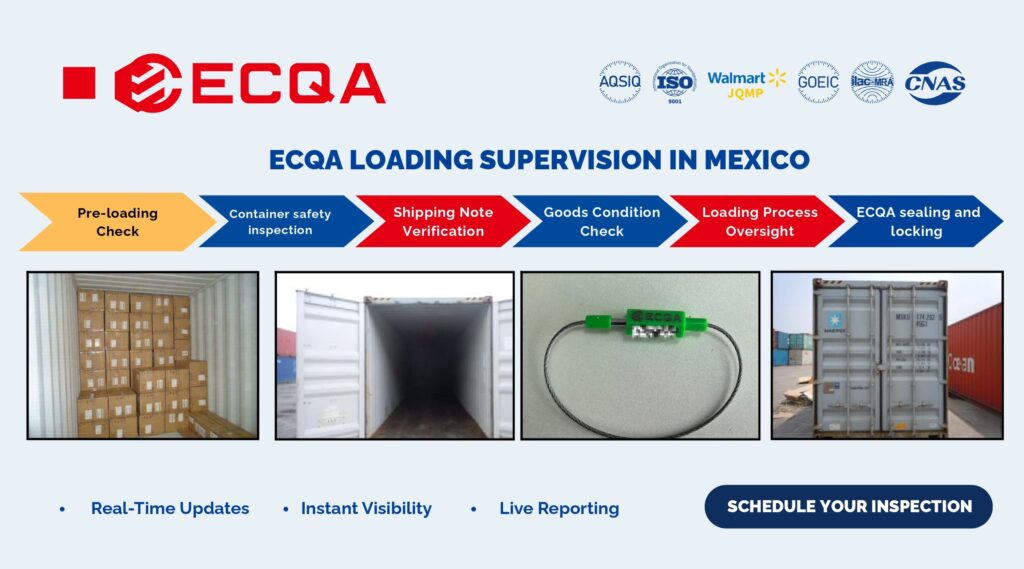
Loading Supervision in Mexico

Mexico handles a wide range of imported goods across automotive, electronics, retail, home goods and industrial sectors. Most shipments arrive through major ports such as Manzanillo, Veracruz, Lázaro Cárdenas and Altamira before being transferred to inland distribution centers. Long transit times and multiple handling stages can introduce several quality risks.
Common issues observed by receiving teams in Mexico include:
- Deformation of outer cartons
- Moisture exposure
- Inaccurate or missing carton markings
- Quantity or assortment mismatches
- Poorly secured cargo inside containers
- Irregularities in seals or sealing records
These issues often originate at the loading site and relate to packaging preparation, cargo arrangement and container condition. Without visibility into the loading process, receiving teams in Mexico may find it difficult to determine where handling problems occurred.
Loading and unloading supervision in Mexico focuses on verifying packaging, cargo condition and handling methods at the point of loading or receiving. By conducting checks directly at facilities in Mexico, inspectors help companies maintain shipment accuracy, confirm compliance with instructions and identify handling issues early.
Key Aspects of Loading and Unloading Supervision in Mexico
Verification of goods
Inspectors confirm that the product type, quantity and general condition match the order, packing list and client requirements.
Packaging and transport readiness
Packaging is reviewed to determine whether it can withstand the planned transport route. This includes checking carton durability, pallet stability and the use of protective materials.
Container condition review
Containers are checked to confirm they are dry, clean and structurally suitable. This reduces the risk of moisture exposure, contamination or impact damage.
Documentation support
All observations, including photos and seal details, are recorded clearly. These records help importers evaluate supplier performance and maintain traceability.
Oversight of handling practices
Inspectors monitor the way cartons, pallets and machinery are positioned and secured during loading. This supports stable transport and reduces the likelihood of movement during sea or land transportation.
Typical Steps in Loading Supervision in Mexico
1. Pre-loading review
- Checking documentation against physical goods
- Inspecting packaging and carton labeling
- Confirming cargo condition before loading begins
2. Container evaluation
- Reviewing interior and exterior structure
- Ensuring the container is free from odors, moisture or residues
- Confirming door functionality and cleanliness
3. Loading oversight
- Monitoring weight distribution
- Reviewing placement of heavy, fragile or irregular items
- Observing the use of straps, blocking materials or airbags
4. Sealing and reporting
- Recording the applied seal number
- Taking photographs of the final loading condition
- Preparing a structured report summarizing findings
Loading and unloading supervision helps importers maintain control and visibility throughout the shipping process. For shipments handled in Mexico, this oversight supports packaging performance, documentation accuracy and safe handling during loading, transit and receiving.
How ECQA Third-Party Loading Supervision Supports Mexico Shipments
ECQA provides loading and unloading supervision to help importers manage shipment quality throughout long supply chains. Inspectors follow structured procedures that verify packaging, container condition and loading practices at the point of origin, and conduct additional checks during receiving when unloading supervision is required.
1. Independent verification at the loading site
Inspectors confirm the type, quantity and condition of goods before loading begins. This supports accuracy and helps reduce handling-related risks.
2. Review of packaging and transport readiness
Packaging is evaluated based on durability, pallet stability and suitability for the transport route.
3. Container condition assessment
Containers are checked for cleanliness, moisture, structural issues and suitability for the planned movement.
4. Monitoring of loading and securing
Inspectors observe how goods are positioned, stacked and stabilized. This helps maintain balance and reduces the likelihood of transport-related movement.
5. Seal verification and documentation
Inspectors apply ECQA security seals to containers and record the final seal number with photos for clear documentation. This gives importers consistent visibility into container integrity at the loading point.
6. Unloading support when required
For companies that require visibility upon arrival, ECQA can review seal condition, record the initial interior state of the container and document cargo condition during unloading.
This combination of checks helps importers manage risk, maintain traceability and ensure consistent handling of shipments within Mexico.

 Request Free Sample Report
Request Free Sample Report